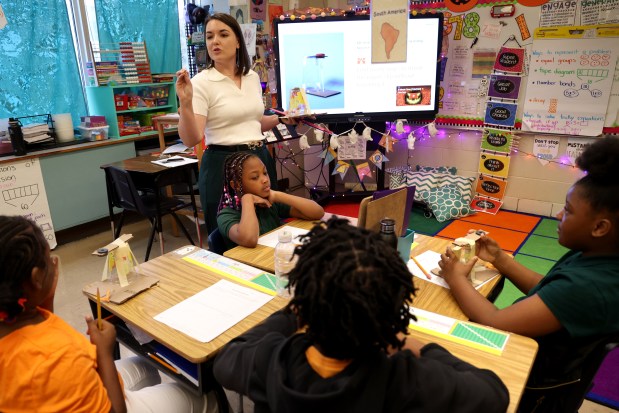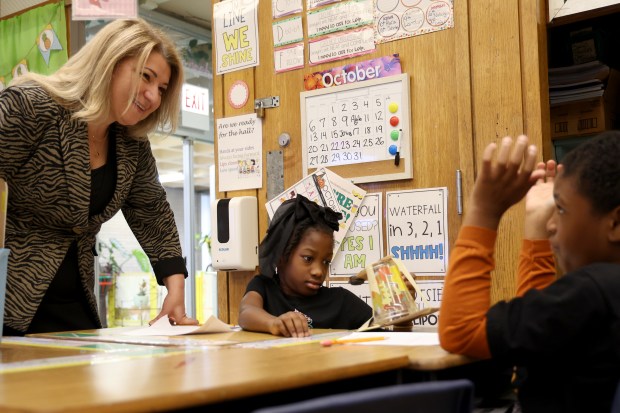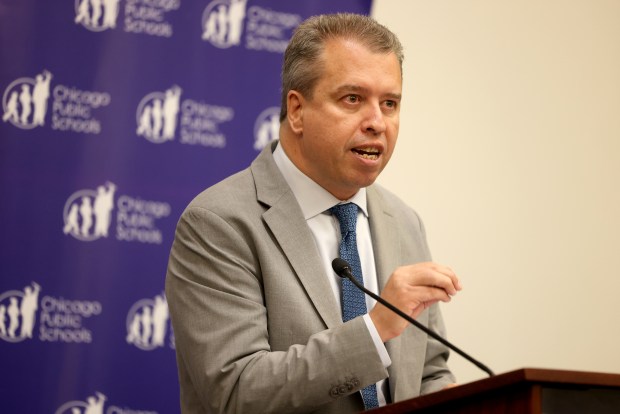There were skeletons on every table in the Collins Academy High School classroom in North Lawndale Tuesday morning, as students carefully placed Play-Doh muscles over the human figurines while glancing at models on their open laptops.
Crystal Brown, 17, said the hands-on approach helped her understand what she needed to know to become a pediatrician.
“I always wanted to help children, like me,” the high school senior said.
Nearby, Chicago Public Schools Chief Executive Officer Pedro Martinez floated from table to table, monitoring the high school students as they built skeletons, asking them what they were learning. He visited Collins Academy on Tuesday to celebrate the recent $40 million approved for three North Lawndale schools: $10 million in tax increment financing and $30 million the Board of Education earmarked in their 2025 budget.
Chalmers STEAM Elementary School, James Weldon Johnson STEAM Elementary School and The Collins Academy STEAM High School are all set to receive funding, which will go toward programming and renovations slated to begin in summer 2025 and be completed by the end of 2026, according to the district’s news release. STEAM stands for the schools’ focus on science, technology, engineering, arts and math programming.
“The STEAM partnership we celebrate today will become a crown jewel of the North Lawndale community,” Martinez said at a news conference at Collins Academy after his classroom visit. “And it’s happening because we chose to work together. Leaders from CPS, the North Lawndale community and city government made a deliberate choice.”
Bolstering offerings at North Lawndale STEAM schools
The $40 million total investment sent excitement buzzing through classrooms Tuesday morning — from educators who have long advocated for more funding to kids who will be directly impacted by the newly announced plans for computer rooms, science labs and hydroponic gardens.
Community leaders said they’ve advocated for the North Lawndale schools for nearly a decade. The North Lawndale Community Action Council and North Lawndale Community Coordinating Council joined forces in 2015 to start campaigning for the schools. STEAM programming began in the North Lawndale schools in the 2024–2025 school year.
“We have worked with three mayors, three CEOs and three sets of members of the Board of Education,” said Betty Green, co-chair of the NLCAC. “There have been many days when I’ve wanted to give up, but I thought about what I used to say to my students. … Quitters never win and winners never quit.”
Principal LaKenya Sanders-Sharpe of Collins Academy said she was particularly excited about the project’s goal to give more students college credit through its partnerships with colleges, universities and industry partners.
The faculty at Collins has always advocated for a college pathway, but the reality is that people also find work in the trades lucrative, Sanders-Sharpe said. She hopes to build up pathways of all kinds.
“I want babies to be able to leave Collins saying, ‘I have a skill set that is going to yield me opportunities,’” Sanders-Sharpe said.
Having tools and equipment to learn science and technology skills is critical, said Kelli Easterly, executive director of the district’s Department of Science, Technology, Engineering, and Mathematics.
“It helps to show our students and teachers that not only do we believe in you, we’re going to give you the environment to reflect that,” Easterly said.
This starts at a young age, said Steve Fisher, principal at Johnson Elementary. Fisher said he was impressed with how quickly his teachers learned and implemented the STEAM curriculum at the start of this year.
“The teachers want to do it,” he said. “And that stems from resources.”
Fisher walked from classroom to classroom with CPS Chief Education Officer Bogdana Chkoumbova and other CPS staff, watching his teachers present unique and interactive lesson plans about science and technology: his elementary students learned about the scientific method by making marshmallows and exercised creativity by pasting leaves on trees.
He gave several students clustered around a table a fist bump, then boasted about how his school would soon have the biggest fish tank in CPS.
“Did everybody see the turtle?” he asked, pointing at a different tank near a classroom.
Martinez’s commitment to community-level TIF investments
The city’s TIF allocation and the district’s investment in the three STEAM schools on the West Side came at a critical time for Martinez, following several tumultuous months of back-and-forth between the mayor, CPS and the Chicago Teachers Union over the district’s plans for funding students’ education, amid a large budget shortfall.
The mayor, a former educator and CTU member who was propelled to office with the help of union donations, recently asked Martinez to step down over his refusal to take out a high-interest $300 million loan to cover the cost of ongoing collective bargaining agreements and a controversial pension payment. Martinez has said the loan would be fiscally irresponsible.

As the district faces a budget gap of hundreds of millions of dollars, made more complicated by the end of federal pandemic relief money and ongoing union contract negotiations, CTU and CPS announced dueling proposals last week to use tax increment financing to solve their budgetary woes.
TIF revenues are generated from incremental property taxes within a specific geographic boundary over a period of 23 years. TIF revenues are meant to be spent by the city on economic development projects within that district, and can pay for infrastructure improvements or other public works or to provide incentives for private developers to set up shop.
Though TIF funds are spent at the city’s discretion, not the school district, CPS benefits from TIF in two ways: direct spending on projects, or by surplus TIFs declared during the city’s budget.
The city’s 124 TIF districts, which rake in hundreds of millions of dollars each year according to data maintained by the city’s Department of Planning and Development, are closely guarded by aldermen, who rely on that funding to deliver on economic development projects in their wards, or fix-ups to local parks, schools and roads.
At the news conference Tuesday, Ald. Monique Scott, 24th, stressed the importance of city investments in neighborhoods such as North Lawndale, where she grew up. She said she’s seen firsthand the neglect and disinvestment in her community, but she also sees the opportunity to invest in schools like STEAM.
“Many kids may not want to see a future in college, but these careers and electronic engineering or sound or radio and TV and camera — that’s so important. And the kids are going to learn that right here at Collins,” Scott said.
This $10 million round of STEAM projects for CPS is paid out of the Midwest TIF, which ended 2023 with a balance of $89.4 million, according to its annual report.
Surplus TIF money is more fungible and can be used by the district to plug its budget holes.
After accounting for upcoming obligations, the city decides how much extra TIF money to surplus, freeing up money for its own budget and other local taxing districts. Surplus TIF revenues are divvied up proportionally to each taxing district: CPS is the biggest beneficiary. Johnson’s 2024 budget included a record TIF surplus of $433.8 million, over half of which went to CPS. The city’s cut of that was $100 million.

On Oct. 9, CTU asked the city to act urgently to phase out all TIFs while Martinez came forward saying he had asked the mayor in April for a partial sweep that would help the district stave off costly borrowing while school officials continue advocating for long-term funding solutions.
CTU President Stacy Davis Gates said Tuesday that Martinez was late to the conversation about TIF surplus and stressed the union has proposals for staffing and resources at STEAM schools beyond TIF money.
“We’re happy to agree to more staffing for arts and STEAM but that would require him to be a partner for our schools and a leader on something other than his own media tour,” she said.
Martinez, who grew up in the Pilsen neighborhood and went to Benito Juarez High School, said at the news conference the district’s investments in the North Lawndale schools were an example of no longer “kicking the can down the road” or “passing the buck.” He addressed possible criticism that Collins’ enrollment was only 200 students, saying that more are being drawn to it because of its unique programming and resources.
Afterward, when asked if his announcement of City Council funding at the three neighborhood STEAM schools showed the importance of community projects instead of the complete TIF phaseout as advocated by CTU, Martinez said most taxpayers don’t know where their money is going.
“My neighbors in Pilsen — everybody whose taxes have tripled or tripled in the last decade — they think all their money is going to schools,” he said. “They’re going to TIFs.”
Martinez emphasized that above all, he is pushing for schools in communities like North Lawndale to have the resources to serve students starting from elementary age.
“Am I appreciative that we get to make our case along with CTA, along with everybody else, about getting some funding for buildings? Absolutely,” Martinez said. “I believe there has to be a long-term plan.”
CPS spokeswoman Mary Ann Fergus interjected.
“Any other questions on topic?” she asked.



